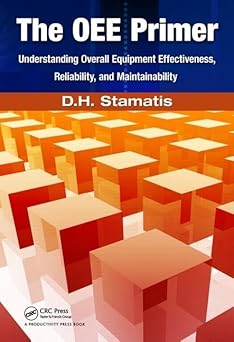
The OEE Primer: Understanding Overall Equipment Effectiveness, Reliability, and Maintainability
by: D.H. Stamatis (Author)
Publisher: Productivity Press
Edition: 1st
Publication Date: 2010/6/14
Language: English
Print Length: 670 pages
ISBN-10: 1439814066
ISBN-13: 9781439814062
Book Description
A valuable tool for establishing and maintaining system reliability, overall equipment effectiveness (OEE) has proven to be very effective in reducing unscheduled downtime for companies around the world. So much so that OEE is quickly becoming a requirement for improving quality and substantiating capacity in leading organizations, as well as a required area of study for the ISO/TS 16949. Breaking down the methodology from a historical perspective, The OEE Primer: Understanding Overall Equipment Effectiveness, Reliability, and Maintainability explores the overall effectiveness of machines and unveils novel methods that focus on design improvement―including hazard analysis, rate of change of failure (ROCOF) analysis, failure rate finite element analysis (FEA), and theory of inventive problem solving (TRIZ). It covers loss of effectiveness, new machinery, electrical maintenance issues, Weibull distribution, measurement techniques, and mechanical and electrical reliability. The book also: Discusses Reliability and Maintainability (R&M), not as tools to be used in specific tasks, rather as a disciplineCovers the application of OEE as an overall improvement toolAssesses existing and new equipment from classical, reliability, and maintainability perspectives Includes downloadable resources with more than 100 pages of appendices and additional resources featuring statistical tables, outlines, case studies, guidelines, and standardsIntroducing the classical approach to improvement, this book provides an understanding of exactly what OEE is and how it can be best applied to address capacity issues. Highlighting mechanical and electrical opportunities throughout, the text includes many tables, forms, and examples that clearly illustrate and enhance the material presented.
About the Author
A valuable tool for establishing and maintaining system reliability, overall equipment effectiveness (OEE) has proven to be very effective in reducing unscheduled downtime for companies around the world. So much so that OEE is quickly becoming a requirement for improving quality and substantiating capacity in leading organizations, as well as a required area of study for the ISO/TS 16949. Breaking down the methodology from a historical perspective, The OEE Primer: Understanding Overall Equipment Effectiveness, Reliability, and Maintainability explores the overall effectiveness of machines and unveils novel methods that focus on design improvement―including hazard analysis, rate of change of failure (ROCOF) analysis, failure rate finite element analysis (FEA), and theory of inventive problem solving (TRIZ). It covers loss of effectiveness, new machinery, electrical maintenance issues, Weibull distribution, measurement techniques, and mechanical and electrical reliability. The book also: Discusses Reliability and Maintainability (R&M), not as tools to be used in specific tasks, rather as a disciplineCovers the application of OEE as an overall improvement toolAssesses existing and new equipment from classical, reliability, and maintainability perspectives Includes downloadable resources with more than 100 pages of appendices and additional resources featuring statistical tables, outlines, case studies, guidelines, and standardsIntroducing the classical approach to improvement, this book provides an understanding of exactly what OEE is and how it can be best applied to address capacity issues. Highlighting mechanical and electrical opportunities throughout, the text includes many tables, forms, and examples that clearly illustrate and enhance the material presented.
未经允许不得转载:电子书百科大全 » The OEE Primer: Understanding Overall Equipment Effectiveness, Reliability, and Maintainability


评论前必须登录!
登陆 注册